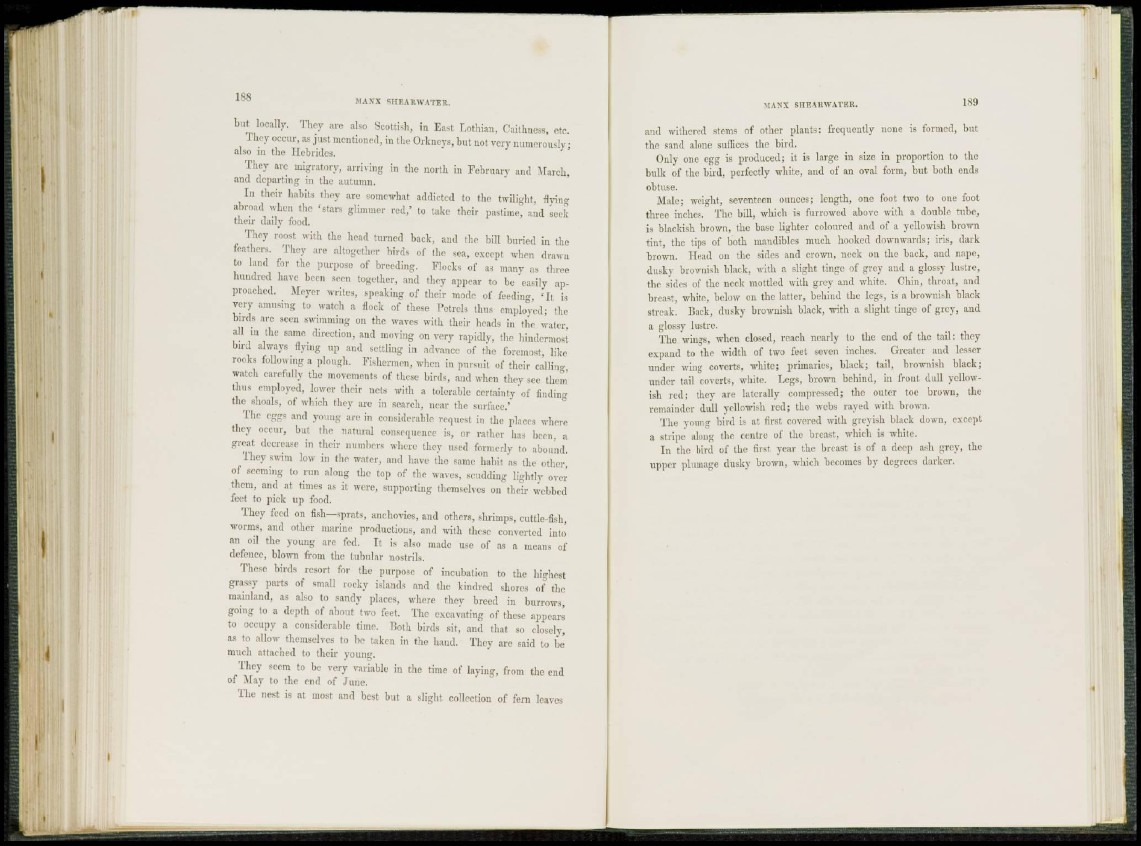
but locally. They are also Scottish, in East Lothian, Caithness, etc.
They occur, as just mentioned, in the Orkneys, but not very numerously;
also in the Hebrides.
They arc migratory, arriving in the north in February and March,
and departing in the autumn.
In their habits they are somewhat addicted to the twilight, flying
abroad when the 'stars glimmer red,' to take their pastime, and seek
their daily food.
They roost with the head turned back, and the bill buried in the
feathers. They are altogether birds of the sea, except when drawn
to land for the purpose of breeding. Flocks of as many as three
hundred have been seen together, and they appear to be easily approached.
Meyer writes, speaking of their mode of feeding, ' It is
very amusing to watch a flock of these Tetreh thus employed; the
b i r d s are seen swimming on the waves with their heads in the water,
all in the same direction, and moving on vcrv rapidly, the hindermost
bird always flying up and settling in advance of the foremost, like
rooks following a plough. Fishermen, when in pursuit of their calling,
watch carefully the movements of these birds, and when they see them
thus employed, lower their nets with a tolerable certainty of finding
the shoals, of which they are in search, near the surface'
The eggs and young are in considerable request in the places where
they occur, but the natural consequence is, or rather has been, a
great decrease in their numbers where they used formerly to abound.
They swim low in the water, and have the same habit as the other,
of seeming to run along the top of the waves, scudding lightly over
them, and at times as it were, supporting themselves on their webbed
feet to pick up food.
They feed on fish—sprats, anchovies, and others, shrimps, cuttle-fish,
worms, and other marine productions, and with these converted into
an oil the young are fed. It is also made use of as a means of
defence, blown from the tubular nostrils.
These birds resort for the purpose of incubation to the highest
grassy parts of small rocky islands and the kindred shores of the
mainland, as also to sandy places, where they breed in burrows,
going to a depth of about two feet. The excavating of these appears
to occupy a considerable time. Both birds sit, and that so closely,
as to allow themselves to be taken in the hand. They are said to be
much attached to their young.
They seem to be very variable in the time of laying, from the end
of "May to the end of June.
The nest is at most and best but a slight collection of fern leaves
and withered stems of other plants: frequently none is formed, but
the sand alone suffices the bird.
Only one egg is produced; it is large in size in proportion to the
bulk of the bird, perfectly white, and of an oval form, but both ends
obtuse.
Male; weight, seventeen ounces; length, one foot two to one foot
three inches. The bill, which is furrowed above with a double tube,
is blackish brown, the base lighter coloured and of a yellowish brown
tint, the tips of both mandibles much hooked downwards; iris, dark
brown. Head on the sides and crown, neck on the back, and nape,
dusky brownish black, with a slight tinge of grey and a glossy lustre,
the sides of the neck mottled with grey and white. Chin, throat, and
breast, white, below on the latter, behind the legs, is a brownish black
streak. Back, dusky brownish black, with a slight tinge of grey, and
a glossy lustre.
The wings, when closed, reach nearly to the end of the tail: they
expand to the width of two feet seven inches. Greater and lesser
under wing coverts, white; primaries, black; tail, brownish black;
under tail coverts, white. Tegs, brown behind, in front dull yellowish
red; they are laterally compressed; the outer toe brown, the
remainder dull yellowish red; the webs rayed with brown.
The young bird is at first covered with greyish black down, except
a stripe along the centre of the breast, which is white.
In the bird of the first year the breast is of a deep ash grey, the
U p p e r plumage dusky brown, which becomes by degrees darker.